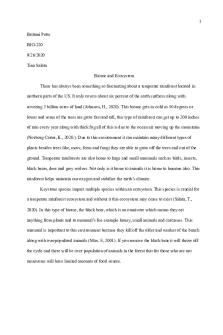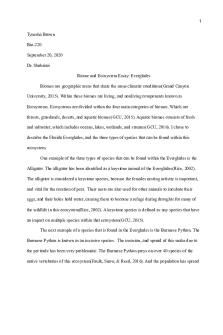Gizmo Prairie Ecosystem PDF

| Title | Gizmo Prairie Ecosystem |
|---|---|
| Course | Principles Of Biology (La-Sci) |
| Institution | Coker University |
| Pages | 5 |
| File Size | 296.8 KB |
| File Type | |
| Total Downloads | 32 |
| Total Views | 127 |
Summary
A biology assignment from a very popular and known biology website....
Description
Student Exploration: Prairie Ecosystem Directions: Follow the instructions to go through the simulation. Respond to the questions and prompts in the orange boxes. Change your text color for your answers. Define Each Vocabulary Word: carnivore-an organism that eats mostly meat, or the flesh of animals consumer-a living creature that eats organisms from a different population ecosystem-a geographic area where plants, animals, and other organisms, as well as weather and landscape, work together to form a bubble of life equilibrium- the current functions of the body are able to keep the body at a stable condition extinct- the dying out of a species food chain-the sequence of transfers of matter and energy in the form of food from organism to organism herbivore-an organism that feeds mostly on plants organism-a living thing that has an organized structure, can react to stimuli, reproduce, grow, adapt, and maintain homeostasis population-a group of individuals of the same species living and interbreeding within a given area prairie-enormous stretches of flat grassland with moderate temperatures, moderate rainfall, and few trees producer-an organism that produces their own food Prior Knowledge Questions (Do these BEFORE using the Gizmo.) An ecosystem consists of all organisms (living things) in an area, plus the natural landscape. A prairie is flat or gently rolling grassland with few trees, such as in parts of the central United States and Canada. Organisms often found in a prairie ecosystem include prairie dogs, swift foxes, black-footed ferrets, and of course the grass itself. 1. Which organism (grass, prairie dog, ferret, or fox) do you think is a producer (does not depend on other organisms for its food)?
grass
2. Organisms that depend on other organisms for food are consumers. Which consumer you think is a herbivore (eats plants only)?
Prairie dogs
3. Which consumers are carnivores (eat meat)?
ferret
Gizmo Warm-up: Life on the Prairie 1. The population of prairie dogs is all the prairie dogs living in the village. In the Gizmo, what are the starting numbers of Grass: 4,000 tons
Prairie dogs:
25,000
and
fox
Ferrets:
80
Foxes:
10
2. Click Advance year 10 times. On the DATA tab, look at the Bar graph and the Line graph. Do the populations change very much, or are they in equilibrium (stable)? Explain. Grass and prairie dogs increase a little bit, but for the most part the data is in equilibrium.
Reproduction for educational use only. Public sharing or posting prohibited. © 2020 ExploreLearning™ All rights reserved
Activity A: Grass
Get the Gizmo ready: ● Click Reset. ● Be sure Show populations is selected.
Question: How is grass important to a prairie ecosystem? 1. Observe: Remove ALL animals from the prairie by clicking the minus (–) button next to each animal many times. Click Advance year 20 times. Does grass survive by itself? Explain. Yes, the grass does survive by itself because it still is receiving energy from the sun and there are no animals feeding on it.
Because grass does not depend on other organisms for food, it is a producer. Grass gets what it needs from the Sun, air, and soil. 2. Predict: Click Reset. Predict what will happen to the prairie dogs, ferrets and foxes if half of the grass were removed. Write “increase” or “decrease” in each blank below. Prairie dogs:
decrease
Ferrets:
decrease
Foxes:
decrease
3. Experiment: Remove about half of the grass by clicking the minus – button. There should now be about 2,000 tons of grass. Click Advance year twice, and look at the Bar graph or the Line graph. What happened to each population—increase or decrease? Prairie dogs:
decrease
Ferrets:
decrease
Foxes:
decrease
4. Think about it: What do you think will happen if you continue advancing years? The animals populations will continue to decrease until the go extinct.
5. Experiment: Test your prediction by clicking Advance year until 20 years have passed.
A. What do you notice?
The animal populations increase
B. Does the ecosystem return to equilibrium? C. How do you know?
Yes The numbers increase back up to where they started at
6. Extend your thinking: Suppose a fire swept through the prairie. The animals ran away, but about half the grass was burned. What would be the long-term results of this natural event? There would be a decrease in prairie dogs which would lead to a decrease in ferrets and foxes.
Activity B:
Get the Gizmo ready:
Making a food chain
● Click Reset.
Reproduction for educational use only. Public sharing or posting prohibited. © 2020 ExploreLearning™ All rights reserved
Question: How do animals affect the prairie ecosystem? 1. Form hypotheses: What do you think each animal in the food chain eats? (Experiment with the Gizmo to help you make your hypotheses.) Prairie dogs eat
grass
. Ferrets eat
Prairie dogs
. Foxes eat
ferrets
.
2. Predict: Based on your hypotheses, predict how the changes below will affect the other animals. Write either “increase” or “decrease” next to each “P” (for “prediction”) in the table. Change Add prairie dogs Add ferrets
Add foxes
Grass
Prairie dogs
P: decrease
Ferrets P: increase
Foxes P: increase
_______________________________________________________
_______________________________________________________
_______________________________________________________
A: decrease
A: increase
A: increase
P: increase
P: decrease
P: increase
_______________________________________________________
_______________________________________________________
_______________________________________________________
A: increase
A: decrease
A: same
P: decrease
P: increase
P: decrease
_______________________________________________________
_______________________________________________________
_______________________________________________________
A: decrease
A: increase
A: decrease
3. Test: Click Reset. Add as many prairie dogs as the Gizmo allows. Click Advance year once. Record the
effects on the other three organisms in the table next to “A” (for “actual”). Then click Reset and do the same with ferrets, and then again with foxes. 4. Analyze: In a food chain, each animal eats only one other animal or plant. Based on your experiments, what is the food that each animal eats? Explain how you know. Prairie dogs eat
grass
. Ferrets eat
Prairie dogs
. Foxes eat
ferrets
.
Explain: Prairie dogs are herbivores, so they only eat plants and ferrets are prey to foxes and foxes are larger. Ferret and foxes are both carnivores
5. Apply: Now complete the Prairie Ecosystem food chain. Arrows point toward the animal that is eating. For example, “Mouse → Hawk” would mean that the mouse is eaten by the hawk. grass
→
Prairie dog
→ ferret
→ foxes
Reproduction for educational use only. Public sharing or posting prohibited. © 2020 ExploreLearning™ All rights reserved
Activity C: Long term changes
Get the Gizmo ready: ● Click Reset.
Introduction: Once common, the black-footed ferret is an endangered animal. In 1986 there were only 18 black-footed ferrets alive; today there are almost 1,000. Question: What would happen to the ecosystem, long-term, with no black-footed ferrets? 1. Form a hypothesis: Based on what you have seen so far, what do you think would happen if black-footed ferrets died out, or went extinct? Explain in detail. The prairie dog population would increase and the fox population would decrease.
2. Experiment: Click Reset, and remove all the ferrets from the prairie dog town. Click Advance year for 12 years. What happens? The population of ferrets and foxes decreased to 0.
3. Analyze: Why did removing ferrets have such a powerful effect on the prairie ecosystem?
Ferrets control the prairie dog population and they are prey to the fox population.
4. On your own: Investigate other major changes to the prairie ecosystem. Run each experiment for 20 years to see what the long-term results would be. A. Give an example of a change that the ecosystem was able to recover from and return to equilibrium. Advancing the fox population will eventually return the ecosystem to equilibrium
B. Give an example of a change that the ecosystem was not able to recover from. Can you explain why? The population of grass is decreasing to 0, therefore every population that relies on grass or relies on an animal that needs grass will decrease until they are extinct.
Complete the assessment on Gizmo
Reproduction for educational use only. Public sharing or posting prohibited. © 2020 ExploreLearning™ All rights reserved...
Similar Free PDFs

Gizmo Prairie Ecosystem
- 5 Pages

Prairie Ecosystem SE
- 4 Pages

Ecosystem report
- 15 Pages

Ecosystem assignment
- 3 Pages

Ecosystem report
- 14 Pages

Biome and Ecosystem
- 5 Pages

Biome and Ecosystem
- 4 Pages

Biome and Ecosystem Essay
- 3 Pages

Biome and Ecosystem Essay
- 4 Pages

Ecosystem Management Plan
- 4 Pages

Biome and Ecosystem
- 5 Pages

Biome and Ecosystem Essay
- 4 Pages

Personal ecosystem for class
- 7 Pages
Popular Institutions
- Tinajero National High School - Annex
- Politeknik Caltex Riau
- Yokohama City University
- SGT University
- University of Al-Qadisiyah
- Divine Word College of Vigan
- Techniek College Rotterdam
- Universidade de Santiago
- Universiti Teknologi MARA Cawangan Johor Kampus Pasir Gudang
- Poltekkes Kemenkes Yogyakarta
- Baguio City National High School
- Colegio san marcos
- preparatoria uno
- Centro de Bachillerato Tecnológico Industrial y de Servicios No. 107
- Dalian Maritime University
- Quang Trung Secondary School
- Colegio Tecnológico en Informática
- Corporación Regional de Educación Superior
- Grupo CEDVA
- Dar Al Uloom University
- Centro de Estudios Preuniversitarios de la Universidad Nacional de Ingeniería
- 上智大学
- Aakash International School, Nuna Majara
- San Felipe Neri Catholic School
- Kang Chiao International School - New Taipei City
- Misamis Occidental National High School
- Institución Educativa Escuela Normal Juan Ladrilleros
- Kolehiyo ng Pantukan
- Batanes State College
- Instituto Continental
- Sekolah Menengah Kejuruan Kesehatan Kaltara (Tarakan)
- Colegio de La Inmaculada Concepcion - Cebu


